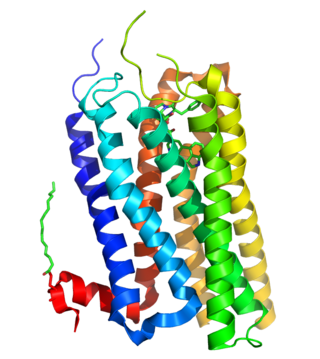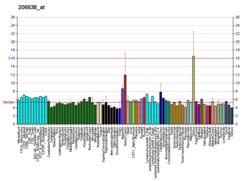Top Qs
Timeline
Chat
Perspective
5-HT2B receptor
Mammalian protein found in Homo sapiens From Wikipedia, the free encyclopedia
Remove ads
5-Hydroxytryptamine receptor 2B (5-HT2B) also known as serotonin receptor 2B is a protein that in humans is encoded by the HTR2B gene.[5][6] 5-HT2B is a member of the 5-HT2 receptor family that binds the neurotransmitter serotonin (5-hydroxytryptamine, 5-HT). Like all 5-HT2 receptors, the 5-HT2B receptor is Gq/G11-protein coupled, leading to downstream activation of phospholipase C.
Remove ads
Tissue distribution and function
Summarize
Perspective
First discovered in the stomach of rats, 5-HT2B was challenging to characterize initially because of its structural similarity to the other 5-HT2 receptors, particularly 5-HT2C.[7] The 5-HT2 receptors (of which the 5-HT2B receptor is a subtype) mediate many of the central and peripheral physiologic functions of serotonin. Cardiovascular effects include contraction of blood vessels and shape changes in platelets; central nervous system (CNS) effects include neuronal sensitization to tactile stimuli and mediation of some of the effects of hallucinogenic substituted amphetamines. The 5-HT2B receptor is expressed in several areas of the CNS, including the dorsal hypothalamus, frontal cortex, medial amygdala, and meninges.[8] However, its most important role is in the peripheral nervous system (PNS) where it maintains the viability and efficiency of the cardiac valve leaflets.[9]
The 5-HT2B receptor subtype is involved in:
- CNS: inhibition of serotonin and dopamine uptake, behavioral effects[10]
- Vascular: pulmonary vasoconstriction[11]
- Cardiac: The 5-HT2B receptor regulates cardiac structure and functions, as demonstrated by the abnormal cardiac development observed in 5-HT2B receptor null mice.[12] Excessive stimulation of this receptor causes pathological proliferation of cardiac valve fibroblasts,[13] with chronic overstimulation leading to valvulopathy.[14][15] These receptors are also overexpressed in human failing heart and antagonists of 5-HT2B receptors were discovered to prevent both angiotensin II or beta-adrenergic agonist-induced pathological cardiac hypertrophy in mouse.[16][17][18]
- Serotonin transporter: 5-HT2B receptors regulate serotonin release via the serotonin transporter, and are important both to normal physiological regulation of serotonin levels in blood plasma,[19] and with the abnormal acute serotonin release produced by drugs such as MDMA.[10] Surprisingly, however, 5-HT2B receptor activation appears to be protective against the development of serotonin syndrome following elevated extracellular serotonin levels,[20] despite its role in modulating serotonin release.
Remove ads
Clinical significance
Valvular heart disease
5-HT2B receptors have been strongly implicated in causing drug-induced valvular heart disease.[21][22][23] The Fen-Phen scandal in the 80s and 90s revealed the cardiotoxic effects of 5-HT2B stimulation.[24] Today, 5-HT2B agonism is considered a toxicity signal precluding further clinical development of a compound.[25]
Migraines
The non-selective serotonin receptor agonist meta-chlorophenylpiperazine (mCPP) induces migraines and this may be due to serotonin 5-HT2B receptor agonism.[26] Serotonin 5-HT2 receptor antagonists used as antimigraine agents, such as methysergide, cyproheptadine, and pizotifen, may be producing their antimigraine effects specifically via serotonin 5-HT2B receptor antagonism.[26]
Remove ads
Ligands
Summarize
Perspective
The structure of the 5-HT2B receptor was resolved in a complex with the valvulopathogenic drug ergotamine.[27] As of 2009, few highly selective 5-HT2B receptor ligands have been discovered, although numerous potent non-selective compounds are known, particularly agents with concomitant 5-HT2C binding. Research in this area has been limited due to the cardiotoxicity of 5-HT2B agonists, and the lack of clear therapeutic application for 5-HT2B antagonists, but there is still a need for selective ligands for scientific research.[28]
Agonists
Endogenous
Selective
- 6-APB – ~100-fold selectivity over the 5-HT2A and 5-HT2C receptors, ≥32-fold selectivity over monoamine release, ~12-fold selectivity over α2C-adrenergic receptor[31][38]
- α-Methylserotonin – ~10-fold selectivity over 5-HT2A and 5-HT2C[35][39][37]
- BW-723C86 – 100-fold selectivity over 5-HT2A but only 3- to 10-fold selectivity over 5-HT2C,[35][40] fair functional subtype selectivity, almost full agonist, anxiolytic in vivo[41]
- LY-266,097 – biased partial agonist in favor of Gq protein, no β-arrestin2 recruitment[42]
- VU6067416 – modest selectivity over 5-HT2A and 5-HT2C[43]
Non-selective
- 25C-NBOMe[31][44]
- 25I-NBOMe[31][44]
- 2C-B[31][44]
- 2C-B-FLY[31][45]
- 2C-C[31][44]
- 2C-D[31][44]
- 2C-E[31][44]
- 2C-I[31][44]
- 4-Methylamphetamine[31]
- 5-APB[31][46][38]
- 5-APDB[31]
- 5-Carboxamidotryptamine[37]
- 5-MAPB[46]
- 6-APB[38]
- 6-APDB[31]
- 6-MAPB[46]
- 5-MeO-αMT[31][33]
- 5-MeO-DiPT
- 5-MeO-DMT[43]
- 5-MeO-MiPT[31][33]
- AL-38022A[47]
- Aminorex (weakly)[48][49]
- Ariadne[50]
- Benfluorex[51]
- Bromo-dragonfly[45][52][53]
- Bromocriptine[54]
- Cabergoline[55][36]
- Chlorphentermine (very weakly)[48]
- CYB210010 (2C-T-TFM)[56][57]
- Dexfenfluramine[58]
- Dexnorfenfluramine[58]
- Dihydroergocryptine[59]
- Dihydroergotamine[55][60]
- DiPT[31][33]
- DOB[31][37]
- DOC[31]
- DOET[61]
- DOI[31][37][36]
- DOM[31][61]
- Ergometrine (ergonovine)[55]
- Ergotamine[55][58][36]
- Fenfluramine[58][36]
- Fenoldopam[36]
- Guanfacine – an α2A-adrenergic agonist, but has 5-HT2B agonistic activity at therapeutic concentrations[36][62]
- Levofenfluramine[58]
- Levonorfenfluramine[58]
- Lorcaserin[55]
- LSD – about equal affinity for human cloned 5-HT2B and 5-HT2A receptors[63][33][64]
- LSM-775[65]
- mCPP (in humans; weak partial agonist)[58][37]
- MDA[31][66]
- MDMA[34][66]
- MEM[67]
- Mescaline[34]
- Methylergometrine (methylergonovine)[55][58][36]
- Methysergide (antagonist in some studies)[58][36][68]
- Naphthylaminopropane[69]
- Norfenfluramine[58][36][40]
- ORG-12962[37]
- ORG-37684[68]
- Oxymetazoline[36]
- Pergolide[55][36][70]
- PNU-22394
- Psilocin[63][64]
- Psilocybin[64]
- Quipazine (weak partial agonist)[37]
- Ro60-0175 – functionally selective over 5-HT2A, potent agonist at both 5-HT2B/C[35][40]
- Ropinirole[36]
- Quinidine[36]
- TFMPP (weak partial agonist)[37]
- VER-3323 – mixed 5-HT2C and 5-HT2B agonist with weaker 5-HT2A affinity[68]
- Xylometazoline[36]
Peripherally selective
Inactive
A number of notable drugs appear to be inactive or very weak as serotonin 5-HT2B receptor agonists, at least in vitro.[31] These include the stimulants and/or entactogens dextroamphetamine, dextromethamphetamine, 4-fluoroamphetamine, 4-fluoromethamphetamine, phentermine, methylone, mephedrone, MDAI, and MMAI, among others.[31][48][38][72][73][74] Findings are somewhat conflicting for certain psychedelics, such as psilocin and LSD, but most studies find that these drugs are indeed potent serotonin 5-HT2B receptor agonists.[64][31][33]
Antagonists
Selective
- 5-HCPC[75][76]
- 5-HPEC (weak)[75]
- 5-HPPC[75]
- AM1125[75]
- AM1476[75]
- BF-1 – derived from pimethixene[75][77][78]
- EGIS-7625 – high selectivity over 5-HT2A[77][79][80]
- EXT5 – highly selective[75][81]
- EXT9 – somewhat selective[75][81]
- LY-23,728[82]
- LY-266,097 – pKi = 9.7, 100-fold selectivity over 5-HT2A and 5-HT2C[35][82]
- LY-272,015 – fairly selective and highly potent[35]
- LY-287,375[82][83]
- MRS7925 – substantially selective over 5-HT2A and 5-HT2C but minimal selectivity over the adenosine A1 receptor[84]
- MRS8209[85]
- MW071 (MW01-8-071HAB) – non-MAOI minaprine analogue[86]
- MW073 – highly selective, orally bioavailable[87]
- PRX-08066 – Ki ≈ 1.7 nM, >100-fold selectivity[75][77][35]
- RQ-00310941 (RQ-941) – Ki = 2.0 nM, IC50 = 17 nM, >2,000-fold selectivity against >60 targets, under development for medical use[75][88][89]
- RS-127,445 (MT-500) – Ki = 0.3 nM, >1,000-fold selectivity over 5-HT2A and 5-HT2C and numerous other targets, selective over at least eight other serotonin receptors, developed for clinical use but discontinued[75][35][77][90][68]
- SB-204,741 – >135-fold selectivity over 5-HT2C and 5-HT2A[91]
- SB-215,505 – mixed 5-HT2B and 5-HT2C antagonist[35][77][92]
- VU6047534 – weak partial agonist or antagonist, peripherally selective in mice but not humans[93][94]
Non-selective
- 2-Bromo-LSD (BOL-148; bromolysergide)[95]
- (–)-MBP – 5-HT2A antagonist, 5-HT2B inverse agonist, and 5-HT2C agonist[96]
- Agomelatine – primarily a melatonin MT1/MT2 receptor agonist, with a less potent antagonism of 5-HT2B and 5-HT2C[97]
- AMAP102 (AMAP-102) – 5-HT2B and 5-HT2C antagonist[75][98]
- Amesergide (LY-237733)
- Amisulpride
- Amitriptyline
- Apomorphine
- Aripiprazole[35]
- Asenapine[35]
- BMB-201 – and active form BMB-39a[99]
- Brexpiprazole
- Brilaroxazine
- C-122[75][35]
- Cariprazine[35][100]
- Chlorpromazine
- Clozapine[68][35]
- Cyproheptadine
- Desmethylclozapine (NDMC; norclozapine)
- Ibogainalog[101]
- ITI-1549[102]
- KB-128 – 5-HT2A and 5-HT2B antagonist and 5-HT2C agonist[103]
- Lisuride – a dopamine agonist of the ergoline class, that is also a 5-HT2B antagonist[104] and a dual 5-HT2A/C agonist[105]
- Lurasidone
- LY-53857
- Mesulergine[68]
- Metadoxine – a 5-HT2B antagonist and GABA-activity modulator[106]
- Metergoline[68]
- Metitepine (methiothepin)[68]
- Mianserin[68]
- Molindone[107][108]
- N-Methylamisulpride
- Nantenine[75]
- Naphthylpiperazine (1-NP)
- Olanzapine
- Pimethixene[78]
- Pipamperone
- Pizotifen (pizotyline)
- Promethazine[109]
- Quetiapine
- Rauwolscine[35]
- Risperidone
- Ritanserin[35][68]
- SB-200,646 – 5-HT2B/5-HT2C antagonist, selective over 5-HT2A
- SB-206,553 – mixed 5-HT2B and 5-HT2C antagonist and PAM at α7 nAChR[77][110][111][68]
- SB-221,284 – 5-HT2B/5-HT2C antagonist[39][68]
- SB-228,357 – 5-HT2B/5-HT2C antagonist
- SDZ SER-082 – a mixed 5-HT2B/C antagonist
- Spiperone
- Tabernanthalog (TBG; DLX-007)[101]
- Tegaserod – primarily a 5-HT4 agonist, but also a 5-HT2B antagonist[112][113]
- Terguride – an oral, potent antagonist of 5-HT2A and 5-HT2B receptors[77][35]
- Trazodone[68]
- Vabicaserin[114]
- Viloxazine – weak 5-HT2B antagonist and 5-HT2C agonist[115][116]
- Xanomeline – similar affinity as for muscarinic acetylcholine receptors[93][117][118]
- Yohimbine[35]
- Zalsupindole (DLX-001; AAZ-A-154)[119]
- Ziprasidone
Unknown or unsorted selectivity
Peripherally selective
- MRS8209[123]
- Sarpogrelate (MCI-9042, LS-187,118) – non-selective 5-HT2 antagonist, but ~2 orders of magnitude lower affinity at 5-HT2B than at 5-HT2A[124][125]
- VU0530244 – 5-HT2B-selective[126]
- VU0631019 – 5-HT2B-selective[126]
- VU6055320 – 5-HT2B-selective[93][94]
- Others (e.g., "compound 19c")[127]
BW-501C67 and xylamidine are known peripherally selective antagonists of the serotonin 5-HT2 receptors, including of the serotonin 5-HT2A and 5-HT2B receptors, but their serotonin 5-HT2B receptor interactions do not appear to have been described.[128][129][130]
Remove ads
Possible applications
5-HT2B antagonists have previously been proposed as treatment for migraine headaches, and RS-127,445 was trialled in humans up to Phase I for this indication, but development was not continued.[131] More recent research has focused on possible application of 5-HT2B antagonists as treatments for chronic heart disease.[132][133] Research claims serotonin 5-HT2B receptors have effect on liver regeneration.[134] Antagonism of 5-HT2B may attenuate fibrogenesis and improve liver function in disease models in which fibrosis is pre-established and progressive.
Remove ads
See also
References
Further reading
External links
Wikiwand - on
Seamless Wikipedia browsing. On steroids.
Remove ads






